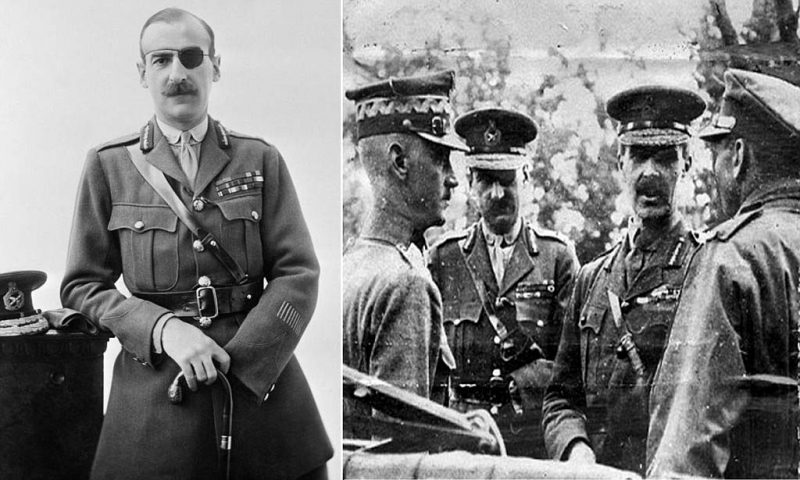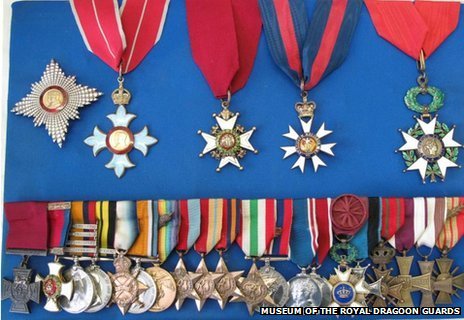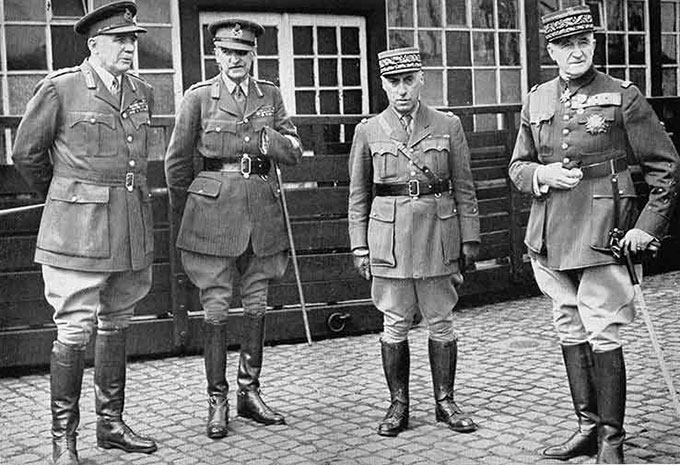
In what many are describing as the best Wikipedia entry ever, the soldier’s page opens with the following paragraph: ‘Sir Adrian Paul Ghislain Carton de Wiart VC, KBE, CB, CMG, DSO (5 May 1880 – 5 June 1963) was a British Army officer of Belgian and Irish descent.
‘He served in the Boer War, First World War, and Second World War; was shot in the face, head, stomach, ankle, leg, hip, and ear; survived a plane crash; tunnelled out of a POW camp; and bit off his own fingers when a doctor refused to amputate them.
‘He later wrote that “Frankly I had enjoyed the war” when describing his service in the First World War.’
Sir Adrian Carton de Wiart was a one-eyed, one-handed war hero who fought in three major conflicts across six decades, surviving plane crashes and PoW camps. His story is like something out of a Boy’s Own comic.
Carton de Wiart served in the Boer War, World War One and World War Two. In the process he was shot in the face, losing his left eye, and was also shot through the skull, hip, leg, ankle and ear.
In WW1 he was severely wounded on eight occasions and mentioned in despatches six times.
Having previously lost an eye and a hand in battle, Carton de Wiart, as commanding officer, was seen by his men pulling the pins of grenades out with his teeth and hurling them with his one good arm during the Battle of the Somme, winning the Victoria Cross.
WW1 historian Dr Timothy Bowman believes Carton de Wiart’s example helps debunk some myths.
“His story serves to remind us that not all British generals of WW1 were ‘Chateau Generals’ as portrayed in Blackadder. He exhibited heroism of the highest order.
“Evelyn Waugh supposedly used Carton de Wiart as the model for his fire-eating fictional creation, Brigadier Ritchie Hook, but Waugh’s fictional creation experienced considerably fewer adventures than his real life counterpart.”
It says much for Carton de Wiart’s character that despite being one of the most battle-scarred soldiers in the history of the British Army, he wrote in his autobiography: “Frankly, I had enjoyed the war.”
He was born into an aristocratic family in Brussels on 5 May 1880. In 1891 he was sent to boarding school in England, going on to study law at Oxford.
In 1899 he saw the opportunity to experience his first taste of war. Abandoning his studies, he left for South Africa to serve as a trooper in the British Army during the second Boer War. As he was under military age, wasn’t a British subject and didn’t have his father’s consent, he pretended to be 25 and signed up under a pseudonym. It was a baptism of fire which ended with him receiving bullet wounds to the stomach and groin, necessitating a return to England. Although eager to get back in the mix again, he had to wait more than a decade to experience further front-line action.
At the outbreak of WW1 in November 1914, Carton de Wiart, now naturalised as a British subject, was serving with the Somaliland Camel Corps, fighting the forces of the Dervish state. During an attack on an enemy stronghold, he was shot in the arm and in the face, losing his left eye and part of his ear. He received the Distinguished Service Order (DSO) for his exploits. Speaking in 1964 Lord Ismay, who served alongside Carton de Wiart in Somaliland, described the incident:
“He didn’t check his stride but I think the bullet stung him up as his language was awful. The doctor could do nothing for his eye, but we had to keep him with us. He must have been in agony.” Lord Ismay also gave an insight into Carton de Wiart’s innate love of fighting:
“I honestly believe that he regarded the loss of an eye as a blessing as it allowed him to get out of Somaliland to Europe where he thought the real action was.”
Carton De Wiart was awarded the Victoria Cross for actions at La Boiselle.
He returned to England to recover in a nursing home in Park Lane. He was to return to this same place on each subsequent occasion he was injured. This became such a regular occurrence that they kept his own pyjamas ready for his next visit.
While recuperating from these injuries, Carton de Wiart received a glass eye. It caused him such discomfort that he allegedly threw it from a taxi and instead acquired a black eye patch.
Such setbacks were not to delay him long. He soon realised his ambition to fight on the Western Front when he was sent to Ypres in May 1915.
During the Second Battle of Ypres, the Germans launched an artillery barrage in which Carton de Wiart’s left hand was shattered. According to his autobiography, Happy Odyssey, he tore off two fingers when the doctor refused to amputate them. His hand was removed by a surgeon later that year.
The way he overcame injury and disability remains an inspiration, says Colour Sgt Thomas O’Donnell, who served in Afghanistan with the 1st Battalion Scots Guards. “For him to have endured all those injuries and gone through so much rehabilitation in so many conflicts and to never give up is really inspirational, particularly given the inferior medical facilities they had then. I just don’t know how he managed it.
“Soldiers like Carton de Wiart are a real example for troops serving today. It’s quite sad that having sacrificed so much his story isn’t particularly well-known. I think as well as remembering the war dead, it is vital we remember what injured soldiers like him went through in countless conflicts.”
After a period of recovery, Carton de Wiart once more managed to convince a medical board he was fit for battle. In 1916, he took command of the 8th Battalion, Gloucestershire Regiment, and while commanding them at the Somme his legend was cemented.
He electrified his men. The eye patch, empty sleeve and striking moustache, combined with his bravery, made him famous, with men under his command describing his presence as helping to alleviate their fear before going over the top.
During fierce fighting, the battle for the village of La Boiselle swayed back and forth. When three other commanding officers were killed, Carton de Wiart took charge of all units fighting in the village and led from the front, holding off enemy counterattacks.
He received the Victoria Cross, the highest British military award for gallantry, for his actions at La Boiselle. He, however, declined to even mention the medal in his autobiography, later telling a friend that “it had been won by the 8th Glosters, for every man has done as much as I have”.
He took part in a number of other offensives during the war, picking up more injuries. Mr A Holmes, who served as Carton de Wiart’s “batman” or personal servant, told the 1964 BBC Home Service programme, In Our Time, how his commanding officer had a particularly lucky escape during another Somme offensive.
“They shifted us from Ypres then back on the Somme again to the Devil’s Wood, and that’s where the old man got shot through the back of the head. But fortunately it missed his spinal cord.”
Some historians have contended that Carton de Wiart’s bravery at times bordered on recklessness, and that this may have explained his being passed over for promotion to divisional command in WW1.
But Bowman believes there were mitigating factors. “He was a brave soldier and effective leader of men. He was well qualified to hold divisional command, but so were many others, and his habit of turning up in the front line and getting himself injured didn’t bode well for his ability to manage a division.
Carton de Wiart lived in Poland for most of the inter-war period but his military career was not yet over. When World War Two broke out, he led a campaign in Norway in 1940 and was briefly stationed in Northern Ireland.
In April 1941 he was dispatched to form a British military mission in Yugoslavia, but his aircraft was shot down over the Mediterranean. After swimming to shore, he was captured by the Italians. Despite being in his 60s, he made numerous attempts to escape the PoW camp, on one occasion eluding recapture for eight days – quite a feat given his distinctive appearance and lack of Italian.
He was eventually released over two years later and was then sent to China by Winston Churchill to be his personal representative to Nationalist leader Chiang Kai-shek, a post he held until 1946.
.

